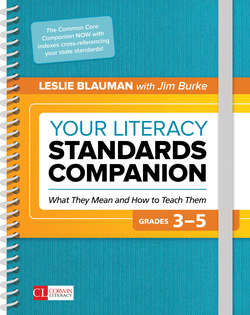Читать книгу Your Literacy Standards Companion, Grades 3-5 - Leslie Blauman - Страница 35
На сайте Литреса книга снята с продажи.
Common Core Reading Standard 2: Academic Vocabulary: Key Words and Phrases
ОглавлениеAnalyze their development over the course of the text: Refers to the careful and close examination of the parts or elements from which something is made and how those parts affect or function within the whole to create meaning.
Central ideas or messages: Some ideas are more important to a work than others; these are the ideas you could not cut out without fundamentally changing the meaning or quality of the text. Think of the “central” ideas of a text as you would the beams in a building: They are the main elements that make up the text and that all the supporting details help to develop.
Characters respond to challenge: In literature, characters are faced with problems and they respond or react to these problems or challenges. The way they react moves the story along and adds to the event sequence.
Conveyed through particular details: This refers to the way authors might explore an idea (e.g., the sense of isolation that often appears throughout dystopian novels) by referring to it directly or indirectly through details that evoke the idea (such as isolation).
Determine central message: Some ideas are more important to a work than others; these are the ideas you could not cut out without fundamentally changing the meaning or quality of the text. Think of the “central message” of a text as you would the beams in a building: they are the main elements that make up the text and which all the supporting details help to develop.
Development: Think of a grain of rice added to others one at a time to form a pile; this is how writers develop their ideas—by adding imagery, details, examples, and other information over the course of a text. Thus when one “analyzes (the) development” of an idea or theme, for example, they look at how the author does this and what effect such development has on the meaning of the text.
Diverse cultures: The United Nations has defined cultural as follows: “Culture should be regarded as the set of distinctive spiritual, material, intellectual and emotional features of society or a social group, and that it encompasses, in addition to art and literature, lifestyles, ways of living together, value systems, traditions and beliefs.” Taking that into account, diverse cultures are ones with cultural variety and cultural differences that exist throughout the world or within a society.
Fables: A legendary story of supernatural happenings or a narrative that attempts to impart a truth (often through a moral)—especially in stories where animals speak and have human characteristics. A fable can also be about legendary people and their tales.
Folktales: These started as an oral tradition—short stories or legends passed down by word of mouth through the generations. These tales or legends were part of a common group of people or folk, and may include supernatural elements. Folktales generally reflect or validate certain aspects of the culture or group. Fairy tales are a subgenre of folktales.
Key supporting details and ideas: Important details and ideas support the larger ideas the text develops over time and are used to advance the author’s claim(s). Not all details and ideas are equally important, however, so students must learn to identify those that matter the most in the context of the text.
Main idea: The most important or central idea of a paragraph or of a larger part of a text. The main idea tells the reader what the text is about and is what the author wants you to remember most.
Moral: Used in Standard 2, a moral is a lesson that concerns what is the right or the correct thing to do and can be derived or inferred (or in some cases stated literally) from a story—usually a fable.
Myth: A traditional or legendary story, usually with supernatural beings, ancestors, and heroes. These stories serve to explain the worldview of a people by explaining customs, society, or phenomenon of nature. Perhaps the most common are Greek and Roman myths, which have deities and demigods.
Objective summary: Describes key ideas, details, or events in the text and reports them without adding any commentary or outside description; it is similar to an evening “recap” of the news, which attempts to answer the reporter’s essential questions: who, what, where, when, why, and how.
Retelling and recounting stories, including key details: Retelling and recounting involve students giving an oral account of the key details of a story. They typically include an opening statement, key events listed chronologically, and a concluding statement. (Even though “retelling” and “recount” have slightly different meanings, we use them interchangeably throughout this volume.)
Summary: Identifies the key ideas, details, or events in the text and reports them with an emphasis on who did what to whom and when; in other words, the emphasis is on retelling what happened or what the text says with the utmost fidelity to the text itself, thus requiring students to check what they say against what the text says happened.
Themes: The ideas the text explains, develops, and explores; there can be more than one, but themes are what the text is actually about. Themes can be the central message, the lesson, or what the author wants you to come away with. Common themes are survival, good versus evil, showing respect for others, adventure, love and friendship, and so on.
